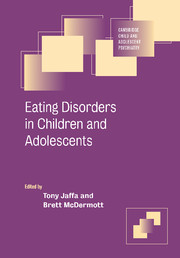Book contents
- Frontmatter
- Contents
- List of Contributors
- Part I Introduction
- Part II Scientific underpinnings
- Part III Abnormal states
- Part IV Evidence-based care
- 16 Assessment and treatment of acute medical complications during the refeeding process
- 17 Assessment and treatment of chronic medical complications
- 18 Individual psychotherapy
- 19 Evidence-based family psychotherapy interventions
- 20 Models of service delivery
- 21 Psychopharmacology and eating disorders
- Part V Public health perspectives
- Index
- References
21 - Psychopharmacology and eating disorders
from Part IV - Evidence-based care
Published online by Cambridge University Press: 02 December 2009
- Frontmatter
- Contents
- List of Contributors
- Part I Introduction
- Part II Scientific underpinnings
- Part III Abnormal states
- Part IV Evidence-based care
- 16 Assessment and treatment of acute medical complications during the refeeding process
- 17 Assessment and treatment of chronic medical complications
- 18 Individual psychotherapy
- 19 Evidence-based family psychotherapy interventions
- 20 Models of service delivery
- 21 Psychopharmacology and eating disorders
- Part V Public health perspectives
- Index
- References
Summary
Introduction
Pharmacological options for the treatment of anorexia nervosa (AN) and bulimia nervosa (BN) are sequentially reviewed within this chapter. Randomized, controlled medication trials represent the primary focus of discussion. The majority of pharmacotherapy research in AN and BN has been conducted with adult patients. Owing to potential pathophysiological or pharmacokinetic differences, it is unclear how results derived from these trials translate into the treatment of paediatric or adolescent patients.
Psychotropic use in children
Particularly when treating younger children, the prescriber is left with the task of designing age-specific dosage regimens. Pharmacokinetic parameters change markedly with age, including absorption, metabolism, distribution and elimination. Further, although the literature on pharmacodynamics is sparse in paediatrics, it is generally assumed that developmental changes influence drug action and response. For a discussion on these paediatric pharmacology issues, the reader is referred to a review by Kearns et al. (2003).
Antidepressants
Underweight patients have an increased risk of arrhythmia with tricyclic antidepressants (TCAs) (Kotler & Walsh, 2000) and an association between certain TCAs and sudden death in children has been identified. A 2001 review describes eight cases of sudden death in paediatric or adolescent patients, six of which involved desipramine monotherapy and two of which involved imipramine in combination therapy (Varley, 2001). As discussed in this report, desipramine may be more specifically toxic compared with other TCAs, and imipramine may be implicated because it is metabolized to desipramine.
- Type
- Chapter
- Information
- Eating Disorders in Children and Adolescents , pp. 260 - 276Publisher: Cambridge University PressPrint publication year: 2006

